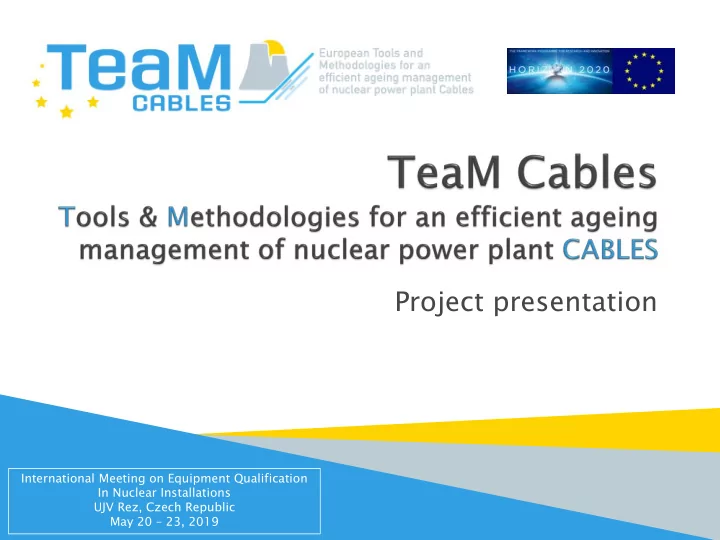

Project presentation International Meeting on Equipment Qualification In Nuclear Installations UJV Rez, Czech Republic May 20 – 23, 2019
13 partners – 6 countries Start: September 2017 Budget: 5.5 M€ The TeaM Cables consortium involves EC Funding : 4.2 M€ participants covering the main players of the NPP cable research, including one cable End: February 2022 manufacturer, renowned research institutes and academia and NPP industry: 1. Electricite De France (EDF) 2. Framatome GmbH (Former Areva GmbH) 3. Institut De Radioprotection Et De Surete Nucleaire (IRSN) 4. Commissariat à l’Energie Atomique et aux Energies Alternatives (CEA) 5. UJV REZ, A.S. 6. ARTTIC 7. Nexans France S.A.S 8. Instytut Chemii i Techniki Jadrowej (INCT) 9. Fraunhofer Gesellschaft Zur Foerderung Der Angewandten Forschung E.V. (IZFP) 10. Teknologian tutkimuskeskus VTT Oy 11. Universite d‘Aix Marseille (AMU) 12. Ecole Nationale Superieure d‘Arts et Metiers (ENSAM) 13. Alma Mater Studiorum - Universita di Bologna 2
Nuclear Power Plant Temelin (Czechia) ◦ ~15 600 cables important to safety / unit ◦ 1,000 km total length Electrical cables are everywhere Complete cable replacement is expensive Electric cables are diverse with different designs and materials Polymer ingredients impact dramatically polymer properties and ageing (at least 5 ingredients in one industrial polymer) Need for: Accurate predictive lifetime models Methods and tools for on-site monitoring of cables 3
The main innovation of the project is a new way of estimating the lifetime duration of cables, using much more precise information and more relevant methods for analysing the data. The approach is based on multi-scale studies of the materials . 4
TeaM Cables aims at providing NPP operators with a novel methodology for efficient and reliable NPP cable ageing management by 1. developing cable ageing models and algorithms based on multi-scale studies and addressing the problem of complex polymer formulation 2. developing methodologies for on-site monitoring and identifying associated criteria from multi-scale relations 3. developing a novel numerical tool integrating the models developed and providing the residual lifetime of cables by crossing on-site measurements with predictive models and knowledge of cable exposure conditions (wiring network in the NPP). 5
Material Silane crosslinked PE Silane crosslinked PE + phenolic antioxidant Silane crosslinked PE + thioether antioxidant Silane crosslinked PE + phenolic antioxidant + thioether antioxidant Silane crosslinked PE + x phr of ATH Silane crosslinked PE + y phr of ATH Silane crosslinked PE + ATH + phenolic and thioether antioxidant Coaxial model cable. LSZH jacket, XLPE insulation, not filled, just antioxidant and stabiliser Twisted pair model cable. LSZH jacket outer, standard NPP insulations material: • XLPE insulation, not filled, just antioxidant and stabiliser XLPE • XLPE insulation + antioxidant + ATH (material No 7) • EVA/EPDM 6
7
8
Thermal ageing: ◦ at 3 temperatures 87 ° C, 110 ° C and 130 ° C Radiation ageing: ◦ At 87 ° C and 6 Gy/h ◦ At 45 ° C and 6 Gy/h ◦ At 45 ° C and 70 Gy/h ◦ At 21 ° C and 500 Gy/h Accident simulations 9
Bottom Mod1 Mod5 Mod6 Top 10
11
12
EQ Accident and post-accident simulations Design basis event (DBE) or severe accident (SA) simulation consists in: • Accident dose irradiation • Thermodynamic profile • Post accident period • Functionality testing 13
Ac Accide cident nt si simulatio mulation Typical procedure is sequential test: Accident dose irradiation followed by thermodynamic profile simulation TeaM Cables Both approaches will be tested and compared: 1. Sequential tests, irradiation followed by steam load 2. Simultaneous action of irradiation and steam load Properties will be evaluated on new as well as on already aged cables. 14
Po Post st-Ac Accide cident nt si simulation mulation Following the DBE, a post DBE period in submerged conditions has to be simulated. This may take 1 year or even more for severe accidents. Such a long period needs to be accelerated. • at elevated temperature and pressure • influence of chemicals • electrical loading Questions about appropriate time for simulation: → How to accelerate the test? → What is the minimum time for testing? 15
Post Po st-Ac Accide cident nt si simulation mulation Typical procedure for 1 year post-accident period: Acceleration using Arrhenius approach, 1 month test TeaM Cables Both approaches will be tested and compared: 1. Full 1 year post-accident period will be simulated 2. Accelerated at higher temperature, 1 month test Cables will be loaded throughout the period with rated voltage and current, and properties will be evaluated. 16
Reinforce safety of Improve the market profile of generation II and III reactors EU-based reactor designs Confirm a safe extension of New knowledge on polymers and cables the lifetime of NPP cables useful also in other industry sectors Improve public perception of nuclear safety through specific dissemination actions Improve innovation capacity and Contribute to new or improved integration of knowledge standards within IEC/TC45 A, IEC/ SC45A and CENELEC TC45 committees 17
Contact: Project Director, Gregory Marque Team-cables-contact@eurtd.com Presented by Vit Placek, UJV Rez WWW.TEAM-CABLES.EU 18
Recommend
More recommend